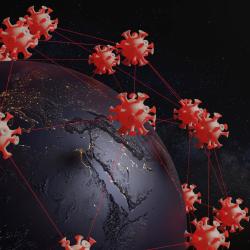Humans Get in the Way of Mammal Movement
Humans modify natural landscapes in a variety of ways, from constructing expansive cityscapes to fencing off otherwise untouched rangeland. A new study, co-authored by biologists at the University of Maryland, describes the extent to which highly modified landscapes impede the movement of 57 land-based mammal species from around the world. On average, these mammals cover about a third to half of the distance they would otherwise travel in wild, unmodified landscapes.
An international team of more than 100 co-authors published its findings in the January 26, 2018 issue of the journal Science. While many previous studies have examined individual species at local and regional scales, the new work is the first to integrate many species across the globe in a single analysis. According to the researchers, their findings could have far-reaching consequences for ecosystems and, as a result, for human society.
“The magnitude of the effects we observed was really surprising. The reduction of movement on a 10-day scale, that percentage drop was just phenomenal. In some cases, we saw a tenfold decrease in movement,” said William Fagan, professor and chair of the UMD Department of Biology and a co-author of the study. “This is after accounting for other factors we already know to be important to animal movement, such as body size, diet and available food resources.”
Most mammals are on the move every day, searching for food, shelter or a mate. In general, larger mammals like zebra move longer distances, while smaller mammals such as hares cover shorter distances. In this study, the researchers collated GPS-tracked movement data from 803 individual animals representing 57 mammal species from around the globe. They used the data portal, Movebank, which archives movement data from researchers across the world.
The researchers then compared these movement data to a metric called the Human Footprint Index, which assigns landscapes a rating that ranges from zero (untouched natural areas) to 50 (dense urban cityscapes). The researchers’ analysis primarily focused on areas with a rating of 36 or higher, comparing these data with baseline information from areas with an index of less than two.
The team also assessed each species’ movements on a variety of time scales ranging from an hour to 10 days. On shorter time scales of less than a day, human-modified landscapes did not significantly affect the movement of most species. However, for observations ranging from a day to 10 days, most species reduced their travel distances by an average of at least half.
Human infrastructure such as roads, buildings, bridges and fences create physical barriers to animal movement. But the research also suggests another, somewhat paradoxical reason that mammals move less in human-dominated areas: resources such as food and shelter can be more plentiful.
“Our research suggests that two things are going on,” said Eliezer Gurarie, a principal faculty specialist in the UMD Department of Biology and a co-author of the paper. “First, the world isn’t as free to move around in. But for many animals it’s also less necessary to range widely because humans can indirectly provide food and protection from large predators.”
Gurarie points to the high numbers of white-tailed deer familiar to anyone in the Washington, D.C. metro area, coyotes found within the borders of Chicago, and fishers—a relative of weasels and ferrets—which are native to Canada and the northern United States.
“It was long thought that fishers needed old-growth forest to thrive,” Gurarie said. “But fishers are doing extremely well, for example, around Albany, New York, where there are a lot of naïve squirrels and rabbits that don’t know to avoid this predator.”
Urban-dwelling fishers, much like urban deer and coyote, typically have much smaller home ranges than their counterparts in wild areas.
While some species can cope with reduced movement in less wild landscapes, the researchers note that movement is also important for the ecosystem as a whole. Restricted movement can disrupt food webs, curtail the distribution of plant seeds and interfere with the transport of nutrients contained in animal waste and prey kills.
“It is important that animals move, because in moving they carry out important ecological functions like transporting nutrients and seeds between different areas,” said Marlee Tucker, lead author of the study and a biologist at the Senckenberg Biodiversity and Climate Research Centre and Goethe University in Frankfurt, Germany. “If mammals move less this could alter any of these ecosystem functions.”
Wild mammals can also clash with humans, causing problems that can range from unwanted grazing in crops and gardens to the spread of deadly diseases. Fortunately, land-use planners and developers can implement strategies to minimize conflicts.
“Concentrating development in certain areas can preserve more open space. It’s also possible to leave corridors open for movement,” said Fagan, who is also a research innovation scholar at the National Socio-Environmental Synthesis Center (SESYNC). “These corridors can be as simple as a tunnel under a road. Such measures allow mammals to live in the same landscape without suffering from reduced movement.”
Fagan, Gurarie, Tucker and their colleagues note that the current study, while impressive in scope, is likely only the first of its kind. With access to large amounts of high-quality, globe-spanning data contained in public databases like Movebank, ecologists are keen to continue large-scale, data-driven studies on animal movement.
“This idea of compiling data on animal movement will open the door to new studies that include new species and that look for patterns and similarities in data,” Fagan explained. “It creates opportunities to look more generally at how animal movement affects other environmental features. Some questions can only be asked by gathering together a lot of data. This is one of them.”
###
In addition to Fagan and Gurarie, UMD-affiliated co-authors of the research paper include visiting graduate student Nina Attias, biology principal faculty specialist Christen Fleming, biological sciences graduate student Edward Hurme, and former graduate students Justin Calabrese (Ph.D. ’05, behavior, ecology, evolution, systematics) and Thomas Mueller (Ph.D. ’08, behavior, ecology, evolution, systematics).
The research paper, “Global reductions in terrestrial mammalian movements in human-dominated landscapes,” Marlee Tucker, Katrin Böhning-Gaese, William Fagan, et al., was published January 26, 2018 in the journal Science.
This work was supported by the Robert Bosch Foundation; the Goethe International Postdoctoral Programme; the People Programme (Marie Curie Actions) of the European Union's Seventh Framework Programme (Award No. FP7/2007-2013/[291776]); the German Research Foundation (Award Nos. FR 3246/2-1, AOBJ 576687 and 2118/1 BioMove); the French National Research Agency (Award Nos. ANR FEAR, ANR SAVARID and ANR-16 -CE02-0010-02); the U.S. National Science Foundation (Award Nos. ABI-1458748, 0963022, 1255913, DEB-LTREB 1556248, DDIG 0608467, 1564380, BCS 99-03949 and BCS 1266389); the Irish Research Council (Award No. GOIPD/2015/81); NASA (Award Nos. NNX15AV92 and NNX11AP61G); the Research Council of Norway (Award No. 251112); the GLOBE Project (POL-NOR/198352/85/2013); the University of California, Berkeley Museum of Vertebrate Zoology; the American Society of Mammalogists; the Leverhulme Study Abroad Studentship and ERC (Award No. 323401); the Copenhagen Zoo; the Danish Environmental Protection Agency; the Juni Charity Foundation; the Portuguese Fundação para a Ciência e Tecnologia (Award No. SFRH/BPD/111084/2015); Save the Elephants; the Spanish Ministry of Economy and Competitiveness (Award No. IJCI-2014-19190); the L.S.B. Leakey Foundation; and the University of California, Davis, Committee on Research. The content of this article does not necessarily reflect the views of these organizations.
Written by Matthew Wright





